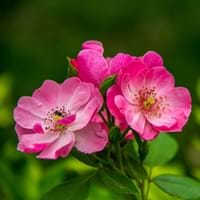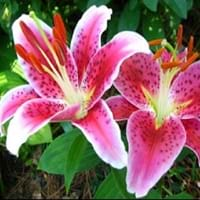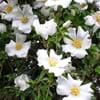Life Span
Perennial
Perennial
Type
Flowering Plants
Bulb or Corm or Tuber
Origin
Europe, India, Northwestern Africa, United States, Western Asia
Hybrid origin, North America, Europe, Africa, Asia
Types
Not Available
Gloriosoides Baker Lily, Speciosum Lily
Habitat
disturbed sites, Roadsides, stream banks, Woods
Not Available
USDA Hardiness Zone
Not Available
2-8
AHS Heat Zone
Not Available
8-1
Sunset Zone
Not Available
21,22
Habit
Upright/Erect
Upright/Erect
Flower Color
Lavender, Light Pink, Pink, Purple, White
White, Yellow, Red, Green, Purple, Gold, Pink, Rose, Peach, Burgundy, Bronze
Flower Color Modifier
Bicolor
Bicolor
Fruit Color
Non Fruiting Plant
Yellow green, Sandy Brown
Leaf Color in Spring
Green, Gray Green, Dark Green
Green, Dark Green
Leaf Color in Summer
Green
Light Green
Leaf Color in Fall
Green, Gray Green, Dark Green
Several shades of Green
Leaf Color in Winter
Green, Dark Green
Light Green
Leaf Shape
Pinnate
Long Linear
Plant Season
Spring, Summer
Spring, Summer, Fall
Sunlight
Partial shade, Partial Sun
Full Sun, Partial Sun, Partial shade
Growth Rate
Medium
Medium
Type of Soil
Clay, Loam
Clay, Loam, Sand
The pH of Soil
Alkaline
Acidic, Neutral, Alkaline
Soil Drainage
Well drained
Well drained
Bloom Time
Spring, Summer
Not Available
Tolerances
Wet Site
Drought
Where to Plant?
Container, Ground, Pot
Container, Ground, Pot
How to Plant?
Seedlings, Stem Planting
Seedlings
Plant Maintenance
Medium
Medium
Watering Requirements
Keep the ground moist but not water-logged
Needs more water during establishment, Use Mulches to help prevent water loss during hot and windy weather, Water daily during growing season
In Summer
Lots of watering
Lots of watering
In Spring
Moderate
Moderate
In Winter
Average Water
Average Water
Soil pH
Alkaline
Acidic, Neutral, Alkaline
Soil Type
Clay, Loam
Clay, Loam, Sand
Soil Drainage Capacity
Well drained
Well drained
Sun Exposure
Partial shade, Partial Sun
Full Sun, Partial Sun, Partial shade
Pruning
cut main flower spike, Remove dead branches, Remove dead or diseased plant parts
Prune in early spring, Prune in fall, Remove dead or diseased plant parts
Fertilizers
Apply 10-10-10 amount, as it is a flowering plant, use high phosphorous content fertilizer
All-Purpose Liquid Fertilizer, Compost, Fertilize only when soil is poor, slow-release fertilizers
Pests and Diseases
Grasshoppers
Lily Beetle
Plant Tolerance
Drought, Wet Site
Drought
Flower Petal Number
Single
Single
Foliage Texture
Medium
Not Available
Foliage Sheen
Matte
Not Available
Attracts
Birds, Small mammals
Not Available
Allergy
Constipation, Diarrhea, Headache, Heartburn, Nausea, Pain and fatigue, Stomach pain, Vomiting
Not Available
Aesthetic Uses
Bonsai, Bouquets, Cottage Garden, Showy Purposes
Beautification, Showy Purposes
Beauty Benefits
Good for skin, Skin Problems
Making cosmetics, Skin cleanser
Edible Uses
Yes
Sometimes
Environmental Uses
Air purification, Food for birds
Not Available
Medicinal Uses
Astringent, Diuretic, Laxative, Vitamin C
Acne, Burns, Heart problems
Part of Plant Used
Flowers, Rose Hip
Whole plant
Other Uses
Making Perfumes, Used as Ornamental plant, Used for its medicinal properties
Cosmetics, Oil is used for aromatherapy, Used As Food, Used as Ornamental plant
Used As Indoor Plant
Yes
Yes
Used As Outdoor Plant
Yes
Yes
Garden Design
Feature Plant, Mixed Border
Alpine, Container, Cutflower, Feature Plant, Mixed Border, Wildflower
Botanical Name
Rosa Arkansana
Lilium speciosum
Common Name
Prairie Rose, Wild Prairie Rose
Japanese Lily
In Hindi
Rosa arkansana
जापानी लिली
In German
Rosa arkansana
Pracht-Lilie
In French
Rosa arkansana
Lily japonais
In Spanish
Rosa arkansana
lirio japonés
In Greek
Rosa arkansana
Ιαπωνικά κρίνος
In Portuguese
Rosa arkansana
lírio japonês
In Polish
Rosa arkansana
japoński lilia
In Latin
Rosa arkansana
lilium Italica
Phylum
Magnoliophyta
Tracheobionta
Class
Magnoliopsida
Liliopsida
Family
Rosaceae
Liliaceae
Clade
Angiosperms, Eudicots, Rosids
Angiosperms, Monocots
Tribe
Not Available
Lilieae
Subfamily
Not Available
Lilioideae
Number of Species
Not Available
Properties of Prairie Wild Rose and Japanese Lily
Wondering what are the properties of Prairie Wild Rose and Japanese Lily? We provide you with everything About Prairie Wild Rose and Japanese Lily. Prairie Wild Rose has thorns and Japanese Lily doesn't have thorns. Also Prairie Wild Rose does not have fragrant flowers. Prairie Wild Rose has allergic reactions like Constipation, Diarrhea, Headache, Heartburn, Nausea, Pain and fatigue, Stomach pain and Vomiting and Japanese Lily has allergic reactions like Constipation, Diarrhea, Headache, Heartburn, Nausea, Pain and fatigue, Stomach pain and Vomiting. Compare all the properties and characteristics of these two plants. Find out which of these plant can be used as indoor plant. If you are interested to decorate your house and garden, find out aesthetic uses, compare them and select the plant which will beautify your surrounding. Along with beautification, try comparing medicinal and edible uses of Prairie Wild Rose and Japanese Lily and you can choose the plant having best and most benefits.
Season and Care of Prairie Wild Rose and Japanese Lily
Season and care of Prairie Wild Rose and Japanese Lily is important to know. While considering everything about Prairie Wild Rose and Japanese Lily Care, growing season is an essential factor. Prairie Wild Rose season is Spring and Summer and Japanese Lily season is Spring and Summer. The type of soil for Prairie Wild Rose is Clay, Loam and for Japanese Lily is Clay, Loam, Sand while the PH of soil for Prairie Wild Rose is Alkaline and for Japanese Lily is Acidic, Neutral, Alkaline.
Prairie Wild Rose and Japanese Lily Physical Information
Prairie Wild Rose and Japanese Lily physical information is very important for comparison. Prairie Wild Rose height is 300.00 cm and width 200.00 cm whereas Japanese Lily height is 30.00 cm and width 30.00 cm. The color specification of Prairie Wild Rose and Japanese Lily are as follows:
Prairie Wild Rose flower color: Lavender, Light Pink, Pink, Purple and White
Prairie Wild Rose leaf color: Green, Gray Green and Dark Green
Japanese Lily flower color: White, Yellow, Red, Green, Purple, Gold, Pink, Rose, Peach, Burgundy and Bronze
- Japanese Lily leaf color: Green and Dark Green
Care of Prairie Wild Rose and Japanese Lily
Care of Prairie Wild Rose and Japanese Lily include pruning, fertilizers, watering etc. Prairie Wild Rose pruning is done cut main flower spike, Remove dead branches and Remove dead or diseased plant parts and Japanese Lily pruning is done Prune in early spring, Prune in fall and Remove dead or diseased plant parts. In summer Prairie Wild Rose needs Lots of watering and in winter, it needs Average Water. Whereas, in summer Japanese Lily needs Lots of watering and in winter, it needs Average Water.





